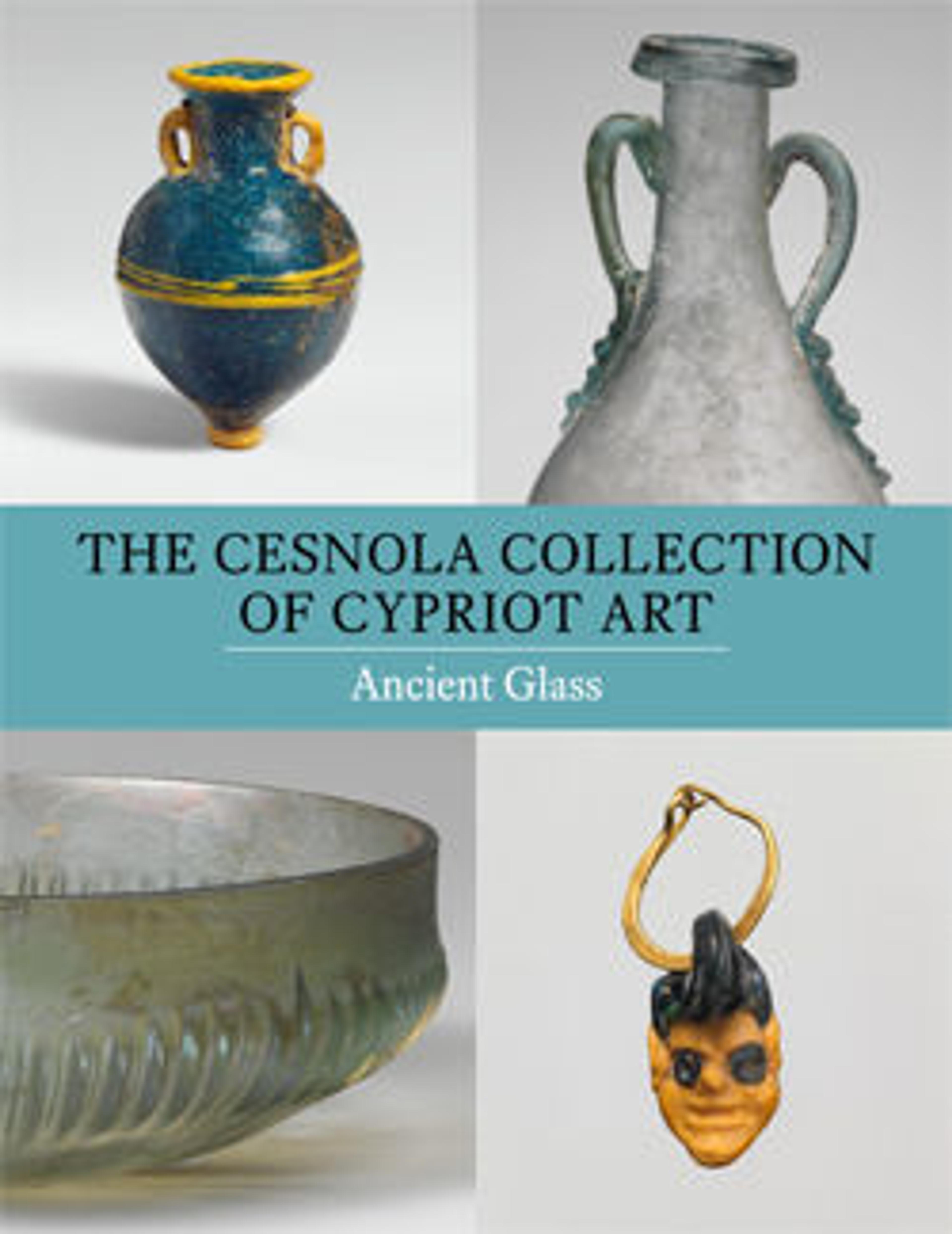Glass amphoriskos (perfume bottle)
Translucent yellow green, appearing black; handles in translucent light green; trails in opaque yellow and opaque white.
Inward-sloping oval rim-disk, with projecting jagged edge to mouth and tooling indent underneath; tall cylindrical neck; small sloping shoulder; conical body, expanding downwards, then turned in sharply to flat bottom; two s-shaped rod handles applied in a loop across shoulder and top of body over trail decoration, drawn up lower part of neck, and then looped out and in, forming large ears, and pressed onto top of neck and underside of rim-disk.
Yellow trail applied around lip of rim and a white trail applied on underside of rim-disk, both then wound in a spiral around neck and shoulder to body, partly as alternating, partly as overlapping lines, then tooled into a close-set festoon pattern with thirty upward strokes on upper two-thirds of body, continuing in a plain spiral around lower part of body, and ending in irregular swirls at center of bottom.
Intact, except for weathered chip in rim-disk; slight pitting of surface bubbles with faint iridescence, some encrustation on handles and neck, and one patch of brown weathering on lower body and bottom.
The production of core-formed glass was revived in the late Hellenistic period, and a smaller number of types and shapes of vessels were employed than in the earlier industry of the fourth to third century B.C. In addition, as seen here, the handles were now larger and were frequently made of a colorless or translucent glass.
Inward-sloping oval rim-disk, with projecting jagged edge to mouth and tooling indent underneath; tall cylindrical neck; small sloping shoulder; conical body, expanding downwards, then turned in sharply to flat bottom; two s-shaped rod handles applied in a loop across shoulder and top of body over trail decoration, drawn up lower part of neck, and then looped out and in, forming large ears, and pressed onto top of neck and underside of rim-disk.
Yellow trail applied around lip of rim and a white trail applied on underside of rim-disk, both then wound in a spiral around neck and shoulder to body, partly as alternating, partly as overlapping lines, then tooled into a close-set festoon pattern with thirty upward strokes on upper two-thirds of body, continuing in a plain spiral around lower part of body, and ending in irregular swirls at center of bottom.
Intact, except for weathered chip in rim-disk; slight pitting of surface bubbles with faint iridescence, some encrustation on handles and neck, and one patch of brown weathering on lower body and bottom.
The production of core-formed glass was revived in the late Hellenistic period, and a smaller number of types and shapes of vessels were employed than in the earlier industry of the fourth to third century B.C. In addition, as seen here, the handles were now larger and were frequently made of a colorless or translucent glass.
Artwork Details
- Title: Glass amphoriskos (perfume bottle)
- Period: Hellenistic
- Date: 2nd–mid-1st century BCE
- Culture: Greek
- Medium: Glass; core-formed, Group III
- Dimensions: 4 9/16 × 2 7/16 × 2 5/16 in. (11.7 × 6.2 × 5.9 cm)
Diam. of rim: 1 1/8 in. (2.8 cm) - Classification: Glass
- Credit Line: Gift of J. Pierpont Morgan, 1917
- Object Number: 17.194.582
- Curatorial Department: Greek and Roman Art
More Artwork
Research Resources
The Met provides unparalleled resources for research and welcomes an international community of students and scholars. The Met's Open Access API is where creators and researchers can connect to the The Met collection. Open Access data and public domain images are available for unrestricted commercial and noncommercial use without permission or fee.
To request images under copyright and other restrictions, please use this Image Request form.
Feedback
We continue to research and examine historical and cultural context for objects in The Met collection. If you have comments or questions about this object record, please contact us using the form below. The Museum looks forward to receiving your comments.
